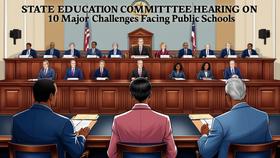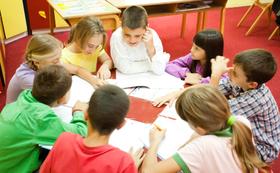Top Rankings
New York City Geographic District # 4 School District ranks among the top 20% of public school district in New York for:
Category
Attribute
Community Size
Largest student body (number of students) (Top 1%)
For the 2025 school year, there are 17 public preschools serving 5,985 students in New York City Geographic District # 4 School District. This district's average pre testing ranking is 4/10, which is in the bottom 50% of public pre schools in New York.
Public Preschools in New York City Geographic District # 4 School District have an average math proficiency score of 30% (versus the New York public pre school average of 38%), and reading proficiency score of 40% (versus the 41% statewide average).
Minority enrollment is 96% of the student body (majority Hispanic), which is more than the New York public preschool average of 62% (majority Hispanic).
Overview
This School District
This State (NY)
# Schools
29 Schools
1,575 Schools
# Students
11,327 Students
680,405 Students
# Teachers
1,052 Teachers
57,270 Teachers
Student : Teacher Ratio
11:1
11:1
Student By Grade
District Rank
New York City Geographic District # 4 School District, which is ranked #552 of all 1,015 school districts in New York (based off of combined math and reading proficiency testing data) for the 2022-2023 school year.
The school district's graduation rate of 68% has decreased from 86% over five school years.
Overall District Rank
#551 out of 1020 school districts
(Bottom 50%)
(Bottom 50%)
Math Test Scores (% Proficient)
(22-23)41%
52%
Reading/Language Arts Test Scores (% Proficient)
48%
49%
Science Test Scores (% Proficient)
70%
78%
Graduation Rate
(22-23)68%
87%
Students by Ethnicity:
Diversity Score
0.57
0.73
% American Indian
1%
1%
% Asian
8%
11%
% Hispanic
62%
31%
% Black
20%
16%
% White
6%
38%
% Hawaiian
1%
n/a
% Two or more races
2%
3%
All Ethnic Groups
Best New York City Geographic District # 4 School District Public Preschools (2025)
School
(Math and Reading Proficiency)
(Math and Reading Proficiency)
Location
Grades
Students
Rank: #11.
P.s. 171 Patrick Henry
(Math: 80% | Reading: 80%)
Rank:
Rank:
9/
Top 20%10
19 E 103rd St
New York, NY 10029
(212) 860-5801
New York, NY 10029
(212) 860-5801
Grades: PK-8
| 774 students
Rank: #22.
Central Park East I
(Math: <50% | Reading: 60-79%)
Rank:
Rank:
8/
Top 30%10
1573 Madison Ave
New York, NY 10029
(212) 860-5821
New York, NY 10029
(212) 860-5821
Grades: PK-5
| 156 students
Rank: #33.
P.s. 83 Luis Munoz Rivera
(Math: 55-59% | Reading: 55-59%)
Rank:
Rank:
7/
Top 50%10
219 E 109th St
New York, NY 10029
(212) 860-5847
New York, NY 10029
(212) 860-5847
Grades: PK-5
| 339 students
Rank: #44.
Central Park East Ii
(Math: 25-29% | Reading: 40-44%)
Rank:
Rank:
4/
Bottom 50%10
433 E 100th St
New York, NY 10029
(212) 860-5992
New York, NY 10029
(212) 860-5992
Grades: PK-8
| 422 students
Rank: #55.
River East Elementary School
(Math: 25-29% | Reading: 30-34%)
Rank:
Rank:
3/
Bottom 50%10
2351 1st Ave
New York, NY 10035
(212) 802-3035
New York, NY 10035
(212) 802-3035
Grades: PK-5
| 244 students
Rank: #66.
Bilingual Bicultural School
(Math: 20-24% | Reading: 30-34%)
Rank:
Rank:
2/
Bottom 50%10
219 E 109th St
New York, NY 10029
(212) 860-6031
New York, NY 10029
(212) 860-6031
Grades: PK-5
| 315 students
Rank: #77.
Lexington Academy
(Math: 17% | Reading: 33%)
Rank:
Rank:
2/
Bottom 50%10
131 E 104th St
New York, NY 10029
(212) 860-5831
New York, NY 10029
(212) 860-5831
Grades: PK-8
| 482 students
Rank: #8 - 98. - 9.
P.s. 146 Ann M Short
(Math: 20-24% | Reading: 25-29%)
Rank:
Rank:
2/
Bottom 50%10
421 E 106th St
New York, NY 10029
(212) 860-5877
New York, NY 10029
(212) 860-5877
Grades: PK-5
| 326 students
Rank: #8 - 98. - 9.
P.s. 155 William Paca
(Math: 20-24% | Reading: 25-29%)
Rank:
Rank:
2/
Bottom 50%10
319 E 117th St
New York, NY 10035
(212) 860-5885
New York, NY 10035
(212) 860-5885
Grades: PK-5
| 255 students
Rank: #1010.
James Weldon Johnson School
(Math: 16% | Reading: 32%)
Rank:
Rank:
2/
Bottom 50%10
176 E 115th St
New York, NY 10029
(212) 876-5522
New York, NY 10029
(212) 876-5522
Grades: PK-8
| 579 students
Rank: #11 - 1211. - 12.
P.s. 108 Assemblyman Angelo Del Toro Educational Complex
(Math: 10-14% | Reading: 30-34%)
Rank:
Rank:
2/
Bottom 50%10
1615 Madison Ave
New York, NY 10029
(212) 860-5803
New York, NY 10029
(212) 860-5803
Grades: PK-8
| 364 students
Rank: #11 - 1211. - 12.
P.s. 7 Samuel Stern
(Math: 10-14% | Reading: 30-34%)
Rank:
Rank:
2/
Bottom 50%10
160 E 120th St
New York, NY 10035
(212) 860-5827
New York, NY 10035
(212) 860-5827
Grades: PK-8
| 400 students
Rank: #1313.
P.s. 102 Jacques Cartier
(Math: 11-19% | Reading: 20-29%)
Rank:
Rank:
1/
Bottom 50%10
315 E 113th St
New York, NY 10029
(212) 860-5834
New York, NY 10029
(212) 860-5834
Grades: PK-5
| 236 students
Rank: #1414.
P.s. 96 Joseph Lanzetta
(Math: 10% | Reading: 24%)
Rank:
Rank:
1/
Bottom 50%10
216 E 120th St
New York, NY 10035
(212) 860-5851
New York, NY 10035
(212) 860-5851
Grades: PK-8
| 422 students
Rank: #1515.
Mosaic Preparatory Academy
(Math: 11-19% | Reading: ≤10%)
Rank:
Rank:
1/
Bottom 50%10
141 E 111th St
New York, NY 10029
(212) 722-3109
New York, NY 10029
(212) 722-3109
Grades: PK-5
| 236 students
Rank: #1616.
P.s. 38 Roberto Clemente
(Math: 10-14% | Reading: 10-14%)
Rank:
Rank:
1/
Bottom 50%10
232 E 103rd St
New York, NY 10029
(212) 860-5882
New York, NY 10029
(212) 860-5882
Grades: PK-5
| 223 students
Rank: n/an/a
535 E 119th St
New York, NY 10035
(212) 860-5868
New York, NY 10035
(212) 860-5868
Grades: PK-2
| 212 students
Recent Articles

The Link Between Education and Incarceration: The NAACP Report
Education and the rate of incarceration have been linked in a recent NAACP report. Learn about the report and the troubling findings.

The Debate Over Mandatory AP Exams: Balancing Academic Rigor and Student Well-being
Some public schools are forcing students in AP courses to take the AP exam. Here's a look at both sides of the debate and the potential benefits in store for both students and high schools.

The 15 Biggest Failures of the American Public Education System
The world is in a constant state of change and those who fail to adjust fall behind. Unfortunately, the American public education system has not kept up with the times and is currently facing a number of serious problems. Keep reading to learn about the biggest failures affecting the modern U.S. public education system as well as some of the trends that could spark change.





